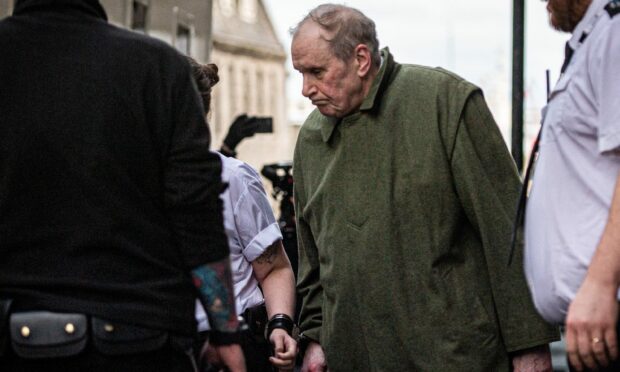The 82-year-old ex-husband of Brenda Page has today been found guilty of her brutal 1978 murder.
Christopher ‘Kit’ Harrisson has been the prime suspect in the infamous murder investigation for more than four decades and has been finally brought to justice.
Brenda, who was the principal of the genetics department at Aberdeen University, was found dead in her Allan Street flat on the morning of July 14 1978.
The 32-year-old had been violently and viciously battered to death with a blunt instrument.
Police identified Cambridge-educated Harrisson as central to their murder probe from the outset, arresting him on the same day Dr Page’s body was discovered.
He was released due to insufficient evidence but was finally arrested in February 2020 following the launch of a reinvestigation of the case in 2015.
The jury of eight men and seven women returned to the High Court in Aberdeen just before 2.40pm and delivered their guilty verdict by majority.
Judge Lord Richardson sentenced Harrisson, 82, to life with a minimum period of 20 years before he would be eligible for parole.
Lord Richardson told Harrisson he had subjected Brenda Page to a “sustained and vicious attack”.
“You struck her at least 20 times to the face and head with a blunt instrument,” he said.
“You continued to hit her even as she sought to protect her face and head with her hands and arms.
“Brenda Page lost consciousness and died whilst in a state of coma from inhalation of blood.
“As a result of your senseless act of violence, you brought the life of Brenda Page to a brutal and premature end.
“You created a void in the lives of her mother, her sister, her nephews and her friends. Her potential as a brilliant scientist was left forever unrealised.”
Harrisson’s defence advocate Brain McConnachie told court: “I don’t think it’s particularly controversial to say under the circumstances of this case, given Dr Harrisson’s age, that he will likely die in custody.
“Clearly, someone with the background of Dr Harrisson will find imprisonment extremely difficult to deal with.”
‘Not a day goes by when we don’t think about Brenda’
Following the verdict, Brenda’s nephew Chris Ling, fought back tears outside court as he read out a statement on behalf of the family.
He said: “We as a family are absolutely delighted with the verdict of today’s trial.
“Brenda’s murder, nearly 45 years ago at the incredibly young age of 32, has affected the family and so many of her friends, work colleagues and of course Police Scotland.
“Not a day goes by when we don’t think about Brenda and the horrendous ordeal she must have suffered that night. Brenda was an extremely kind, intelligent woman with her whole life ahead of her. It hurts us to think of the great things she would have undoubtedly achieved.
“Forty-five years is a long time to be at liberty whilst the family have endured such tragedy, sadness and loss. Reliving these events over and over again each time Brenda’s case was re-investigated or publicised in the media was difficult to say the least.
“It is a great sadness that some of our family and friends are no longer with us to see this day but we are delighted that Brenda’s sister has finally seen Christopher Harrisson found guilty of the brutal crime she always knew he committed.”
Harrisson, who married Brenda in 1972, has always denied murdering his ex-wife.
However, she filed for divorce in 1976 citing “cruelty” and violence on the part of Harrisson.
The couple maintained sporadic contact following the divorce and up until Brenda’s murder.
Detective Inspector Gary Winter, who led Police Scotland’s Major Investigation Team, described Brenda Page as a “brilliant and likeable” scientist, calling her murder “a tragedy”.
He said: “The relationship was not a straightforward relationship, whereby it becomes domestically abusive she leaves him and they never have contact with each other, they do have contact – particularly in 1976 after they divorced.
“Coercive controlling behaviour applies and people behave in ways that we might not think traditionally people would do.”
Key pieces of evidence
One crucial piece of evidence that emerged during the trial came in the form of letters between Brenda and her solicitor Nicol Hosie.
In one letter, she asked him to ensure she got “a good post-mortem” if she should “depart this earth rather suddenly”.
During the murder trial, jurors were also shown a copy of a letter to Harrisson from Brenda in which she told him she wanted “no part” of the “dishonesty with which you surround your life”, adding: “Just get out of my life and stay out.”
DI Winter said: “Reading the letters [between them] and trying to understand where they were at times has helped greatly.
“What the evidence supports from the letters was she was probably in the most vulnerable position when she finally sent him the letter saying it was over.
“We know from studies that that is when the victim is at the greatest risk – when you finally split.
“She seems to be having a practical relationship with him in 1978, that period, and the lead up to the murder doesn’t seem to be abusive and then she writes him the final letter and she is murdered within days.”
Were mistakes made in the initial police investigation?
DI Winter declined to speculate on whether mistakes were made in the initial police inquiry.
Witnesses gave evidence at the trial stating either Brenda or Harrisson made damning disclosures in the days and months before the death.
DI Winter said: “Witnesses give multiple statements in every murder inquiry and those statements aren’t exact replicas of the previous statement.
“We’ll never know, is the short answer to that, because none of us were there in 1978 to see what was said – I wasn’t there in 1978 so I wouldn’t know.”
Around 4,000 people were spoken to by police in relation to the case, with 3,500 statements taken.


